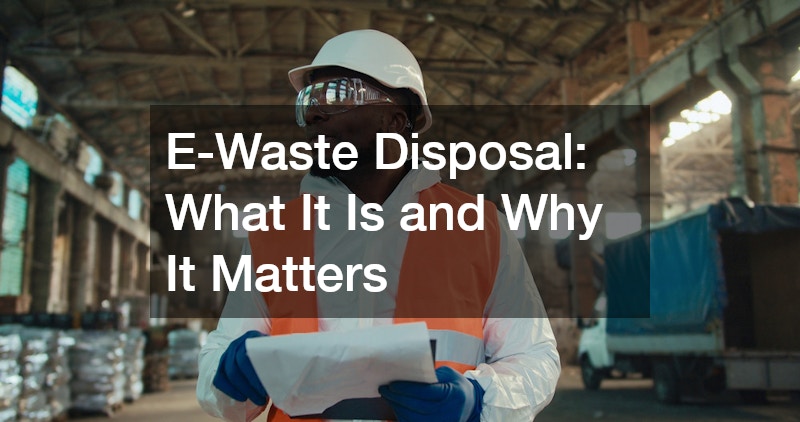
Electronic waste, frequently referred to as “e-waste,” is a growing global challenge that demands immediate attention. Originating from discarded electronic devices, e-waste poses a significant threat to both the environment and human health. Its proper disposal is crucial in order to mitigate potential hazards and conserve valuable resources. This article delves into the intricacies of e-waste, highlighting its implications and exploring viable solutions to this escalating problem.
Defining E Waste
E-waste encompasses a variety of electronic products nearing the end of their useful life. This includes items such as computers, mobile phones, televisions, and other household electronics.
As the pace of technological advancement accelerates, these products quickly become obsolete, dramatically increasing the volume of e waste globally.
The improper disposal of e-waste can lead to severe environmental consequences. Toxic substances like lead, mercury, and cadmium can leach into soil and water, causing significant ecological harm. Furthermore, the extraction of new raw materials to replace discarded electronics exacerbates resource depletion.
Understanding the environmental impact of e-waste is essential for fostering responsible waste management practices. By recognizing the scope of e-waste, individuals and communities can make more informed decisions to mitigate their environmental footprint. The push towards sustainable disposal methods is a vital step in preserving our planet for future generations.
Health Risks Associated with E Waste
The health implications of e waste disposal are concerning, especially for communities in developing countries where informal recycling occurs. Exposure to hazardous materials found in e-waste has been linked to various health issues, including respiratory problems and developmental disorders. Populations working with or living near e-waste recycling operations face heightened risks.
Lead and mercury, common components of e waste, are particularly harmful. When these substances enter the human body, they can cause neurological and organ damage. Pregnant women and young children are especially vulnerable to these toxic exposures.
Encouraging proper e-waste management strategies is a crucial step towards safeguarding public health. Reducing exposure to dangerous materials by implementing stricter regulations and improving recycling methods can significantly decrease the associated health risks. Public education and awareness campaigns are instrumental in promoting safer disposal practices.
Legislative Measures and Responsibility
Strong legislative measures are imperative for managing e waste disposal effectively. Laws and regulations help establish clear guidelines for manufacturers, consumers, and waste management entities regarding their responsibilities. The enforcement of stringent policies ensures compliance and promotes sustainable practices.
Producers bear significant responsibility for the lifecycle of their products. Extended Producer Responsibility (EPR) policies require manufacturers to take accountability for the collection and recycling of e-waste. These measures incentivize the creation of more sustainable products and waste management processes.
Stakeholder collaboration is vital for successful e-waste management. Governments, industries, and consumers must work together to implement and uphold legislation that preserves environmental integrity. Such partnerships are instrumental in the global effort to minimize the harmful effects of e-waste.
Promoting Sustainable Consumption
Individual actions play a fundamental role in addressing e waste issues. Consumers can make a difference by opting for products designed with durability and recyclability in mind. Making informed purchasing decisions cuts down on unnecessary waste and supports sustainable practices.
By prioritizing products with minimal packaging and eco-friendly materials, individuals contribute to waste reduction. Supporting companies that prioritize environmental responsibility helps drive the demand for sustainable products. Consumers hold the power to influence manufacturers through their purchasing choices.
Educating oneself on the effects of e-waste encourages responsible consumer behavior. Awareness of product lifecycles and disposal options empowers individuals to make environmentally conscious decisions. Promoting sustainable consumption is a critical step towards reducing e-waste on a broader scale.
Makeshift Repairs and DIY Fixes
Extending the life of electronic devices can significantly mitigate e-waste production. Encouragement towards DIY repairs and maintenance helps individuals maximize the lifespan of their gadgets. Simple fixes, like replacing a phone battery or upgrading a computer component, can delay the need for new purchases.
Learning basic repair skills cultivates a sustainable mindset. In many cases, repairing a device is cheaper and more environmentally friendly than discarding it. This approach supports a shift from a disposable culture towards one of resourcefulness and innovation.
Access to repair resources and communities can empower individuals to tackle common technological issues. Online tutorials, repair cafes, and community workshops provide valuable support and knowledge sharing. Encouraging repairs fosters a culture of sustainability and responsibility towards electronic assets.
Community Engagement and Awareness
Community-driven initiatives are vital for raising awareness about e-waste issues. Local projects, such as e-waste collection drives and educational programs, bolster community involvement and encourage collective action. Collaborative efforts are crucial in reshaping societal attitudes towards e-waste management.
Awareness campaigns spotlight the importance of responsible e waste disposal. They inform and educate the public on the processes and benefits of proper electronic waste management. Informed citizens are more likely to participate actively in reducing their e-waste footprint.
Communities can establish systems to support e-waste initiatives, such as local recycling centers and designated e-waste drop-off points. By facilitating easy access to proper disposal options, these efforts collectively reduce the strain on existing waste management systems. Community engagement is a powerful tool in the global fight against e-waste.
Proper disposal of e-waste is paramount for maintaining environmental and human health. Collective action from individuals, governments, and industries is required to address this pressing issue. Through responsible e-waste management practices, we can safeguard our planet and ensure a sustainable future for generations to come.
.



